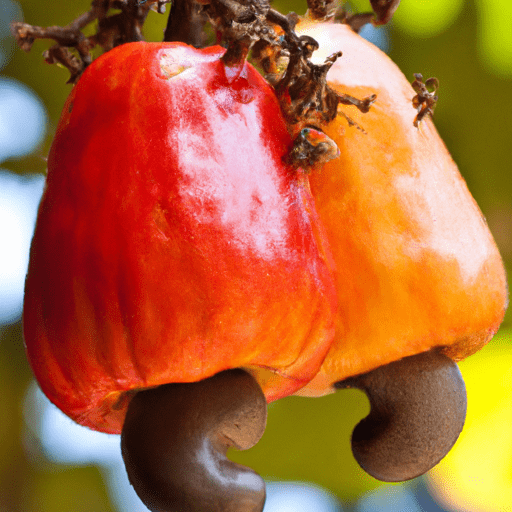The Versatile and Nutrient-Packed Cashew Nut Fruit
Have you ever tasted a cashew nut fruit? This delectable and versatile fruit is not only a feast for the taste buds, but it is also packed with various nutritional benefits. In today’s blog post, we will dive deep into the remarkable attributes of the cashew nut fruit, from its taste and uses in cooking to its nutritional content and intriguing history. So, let’s embark on this flavorful journey!
Tasting the Cashew Nut Fruit
When you think of cashews, you likely envision the pale, kidney-shaped nuts that are commonly found in stores. However, the cashew nut fruit itself is lesser known and often underappreciated. The fruit grows on tropical evergreen trees, originating from Brazil but now cultivated in various countries around the world.
The cashew nut fruit possesses a unique taste that can be described as mildly sweet and tangy. Its vibrant and juicy flesh ranges in color from yellow to red, depending on the maturation stage. Some even compare the taste to a blend of mango and pineapple, offering a delightful tropical experience.
Culinary Uses of the Cashew Nut Fruit
Despite its relative obscurity, the cashew nut fruit offers a plethora of culinary applications. Firstly, its flesh can be enjoyed fresh as a standalone snack, providing a burst of tropical flavors. It can also be incorporated into various sweet and savory dishes to elevate their taste profile.
One popular and refreshing use of the cashew nut fruit is in salads. Sliced or diced, it adds a subtle sweetness and a refreshing bite. Additionally, its juice can be extracted, turning it into a delicious and all-natural beverage. Mixed with soda water or used as a base in cocktails, this juice offers a distinctive taste that will leave your taste buds craving more.
In some cuisines, particularly in Latin America and Asia, the cashew nut fruit is even used to make jams, preserves, and chutneys. Its versatility lends itself to being a wonderful accompaniment to cheese platters, charcuterie boards, and various meat dishes. The possibilities for its use in cooking are truly endless, limited only by one’s culinary imagination.
Nutritional Value of the Cashew Nut Fruit
As with many fruits, the cashew nut fruit not only tantalizes our taste buds but also nurtures our bodies with its nutritional value. It is packed with essential vitamins like vitamin C, vitamin E, and B vitamins, contributing to supporting overall health and vitality.
Furthermore, this fruit provides essential minerals such as potassium, magnesium, and iron. Potassium helps maintain proper blood pressure levels, while magnesium plays a vital role in bone health. Iron is essential for blood production and helps prevent anemia.
Additionally, the cashew nut fruit is rich in dietary fiber. Fiber aids in digestion, supports weight management, and helps maintain healthy cholesterol levels. Incorporating this fruit into your diet can be a beneficial step towards a well-rounded and nutritious lifestyle.
An Intriguing History and Fun Facts
To wrap up our exploration of the cashew nut fruit, let’s delve into its intriguing history and some intriguing facts. The tree bearing this delicious fruit, known as Anacardium occidentale, was originally found in Brazil’s northeastern region. During the 16th century, Portuguese explorers introduced the cashew tree to other parts of Asia and Africa.
Interestingly, the cashew nut, which is botanically not a nut but a seed, has its protective shell attached to the fruit’s bottom known as the cashew apple. The process of separating the “nut” from the fruit is quite fascinating and it requires skilled hands due to the caustic oil found in the shell.
Despite being a tropical delicacy, the cashew nut fruit remains relatively unknown to many. Its unique and delectable taste, combined with its numerous culinary uses and abundant nutritional content, make it a fruit worth discovering and introducing into our cooking repertoire.
So, the next time you spot this remarkable fruit, remember to embrace its versatility and potential for culinary adventure. Whether enjoying it fresh, incorporating it into your favorite dishes, or sipping its invigorating juice, the cashew nut fruit is truly a hidden gem waiting to surprise and delight you.
Do you have any favorite recipes or experiences with cashew nut fruit? Share them with us in the comments below!
Cashew Nut Fruit
Origin: The cashew nut fruit, also known as the cashew apple, is native to northeastern Brazil. It was first spread to other countries by Portuguese explorers during the 16th century.
Appearance: The cashew nut fruit is not actually a true fruit, but a swollen stem called a pseudocarp. It is pear-shaped and can range in color from yellow to red, with a thin skin that is often waxy.
Common Uses: The cashew apple is consumed in many tropical countries as a fresh fruit, often used in juices, jams, candies, and desserts. It can also be fermented into beverages, vinegar, or alcohol.
Nutrient Profile: Despite being less renowned than the cashew nut itself, the cashew nut fruit is rich in nutrients. It contains high amounts of vitamins C and B6, as well as minerals like potassium, magnesium, and iron. Additionally, it is a good source of dietary fiber.
Unique Properties: One fascinating characteristic of the cashew nut fruit is that its vibrant color is not only due to pigments but also the presence of photosynthetic cells in its skin. These cells enable the fruit to continue photosynthesis even after being detached from the plant.
Historical Significance: The cashew nut fruit was highly regarded by indigenous Amazonian communities for its medicinal properties. It was used to treat digestive ailments, diabetes, and respiratory conditions. In traditional medicine, the juice was also believed to be effective against venomous snake bites.
These facts provide an overview of the origins, common uses, nutritional benefits, and unique properties of cashew nut fruit. Its historical significance showcases its long-standing role in traditional medicine.




Use the share button below if you liked it.
It makes me smile, when I see it.